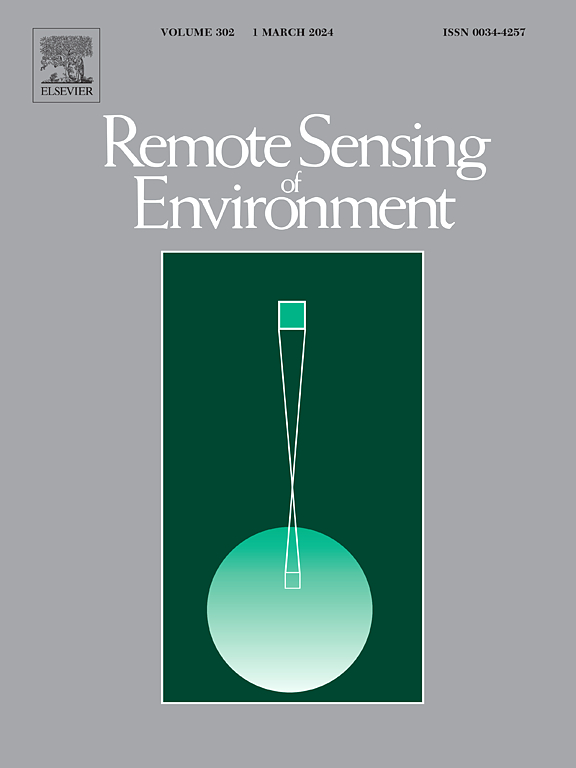Mapping tree species fractions in temperate mixed forests using Sentinel-2 time series and synthetically mixed training data
IF 11.1
1区 地球科学
Q1 ENVIRONMENTAL SCIENCES
引用次数: 0
Abstract
Monitoring and mapping of forest stands, including tree species composition can support forest protection and management. Sentinel-2 imagery provide a viable data source due to their high spectral, temporal, and spatial resolution. However, especially in temperate mixed forests challenges with tree species classification persist, mainly due to the high mixing ratio of tree species, which cannot be fully resolved even with the 10 m resolution of Sentinel-2 data. Additional challenges are associated with the commonly low number of reference data for rare tree species, resulting in low classification accuracy for these species. This study proposes an approach to map sub-pixel tree species fractions in mixed temperate forests by combining dense annual multi-spectral Sentinel-2 time series to target differences between species in phenological relevant periods with synthetically mixed training data. This allows for a limited number of pure training samples per tree species, which serves as basis for randomized linear mixing to compute a synthetic spectral library. An artificial neural network is trained for regression for tree species fractions per pixel. To enhance model robustness and stabilize predictions, we implemented this library generation and artificial neural network regression as an ensemble approach. We effectively mapped tree species fractions for the federal state of Rhineland-Palatinate, Germany, with Mean Absolute Errors of 2.76% to 16.05% and R2 values up to 0.92 – when validated against forest planning data. We show that the data augmentation through synthetic mixing allows for a sample size as small as 30 pure pixels per class, to sufficiently distinguish nine tree species and one ‘other species’ class, hence substantially increasing the operational potential for deployment when reference data for rare species are limited – while simultaneously generating accurate and information-rich tree species distributions over large areas of mixed forest.

基于Sentinel-2时间序列和综合混合训练数据的温带混交林树种组分制图
监测和绘制林分图,包括树种组成,可以支持森林保护和管理。哨兵2号的高光谱、高时间和高空间分辨率提供了一个可行的数据源。然而,特别是在温带混交林,树种分类的挑战仍然存在,主要是由于树种混合比例高,即使使用10 m分辨率的Sentinel-2数据也无法完全解决这一问题。额外的挑战与稀有树种的参考数据通常较少有关,导致这些树种的分类精度较低。本研究提出了一种结合密集的年度多光谱Sentinel-2时间序列,利用综合混合训练数据定位物候相关时期树种间差异,绘制温带混交林亚像元树种组分图的方法。这允许每个树种的纯训练样本数量有限,这可以作为随机线性混合计算合成光谱库的基础。利用人工神经网络对每像素的树种分数进行回归训练。为了增强模型的鲁棒性和稳定预测,我们将该库生成和人工神经网络回归作为集成方法实现。我们有效地绘制了德国莱茵兰-普法尔茨联邦州的树种分数图,当与森林规划数据进行验证时,平均绝对误差为2.76%至16.05%,R2值高达0.92。我们表明,通过合成混合的数据增强允许每类样本大小小至30个纯像素,以充分区分9种树种和1种“其他物种”类别,因此在稀有物种参考数据有限的情况下,大大增加了部署的操作潜力,同时在大面积混混林中生成准确且信息丰富的树种分布。
本文章由计算机程序翻译,如有差异,请以英文原文为准。
求助全文
约1分钟内获得全文
求助全文
来源期刊

Remote Sensing of Environment
环境科学-成像科学与照相技术
CiteScore
25.10
自引率
8.90%
发文量
455
审稿时长
53 days
期刊介绍:
Remote Sensing of Environment (RSE) serves the Earth observation community by disseminating results on the theory, science, applications, and technology that contribute to advancing the field of remote sensing. With a thoroughly interdisciplinary approach, RSE encompasses terrestrial, oceanic, and atmospheric sensing.
The journal emphasizes biophysical and quantitative approaches to remote sensing at local to global scales, covering a diverse range of applications and techniques.
RSE serves as a vital platform for the exchange of knowledge and advancements in the dynamic field of remote sensing.
 求助内容:
求助内容: 应助结果提醒方式:
应助结果提醒方式:


